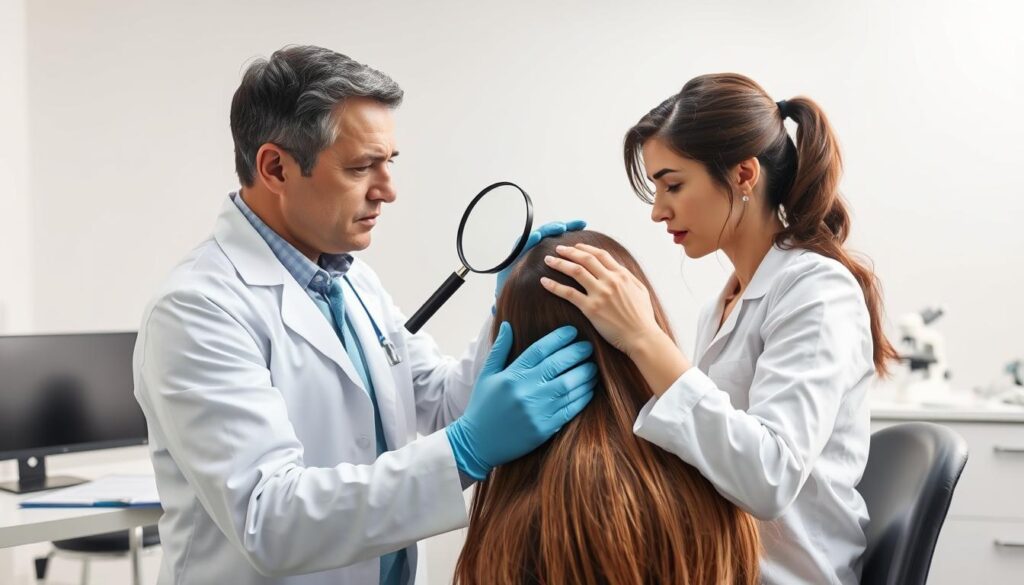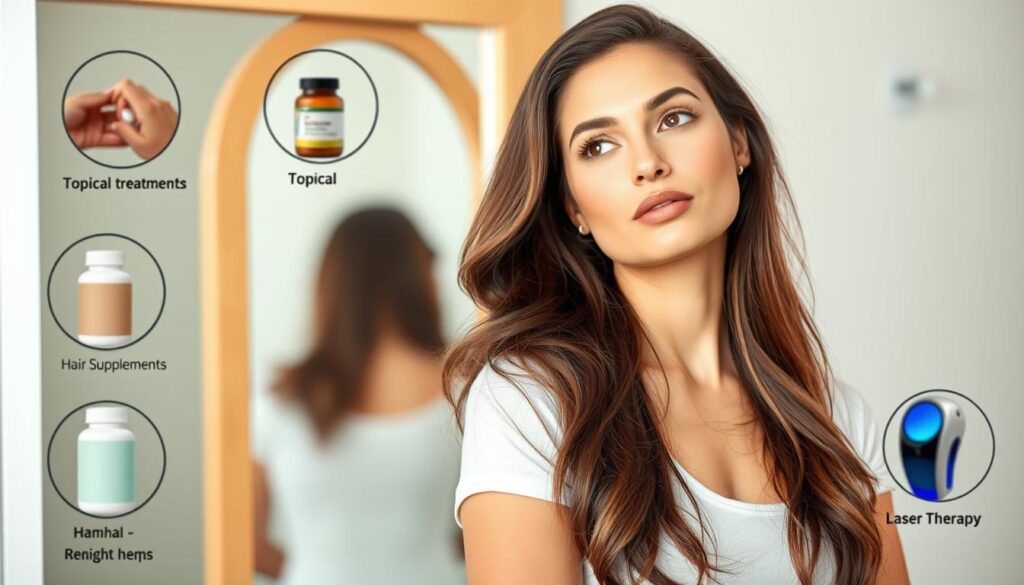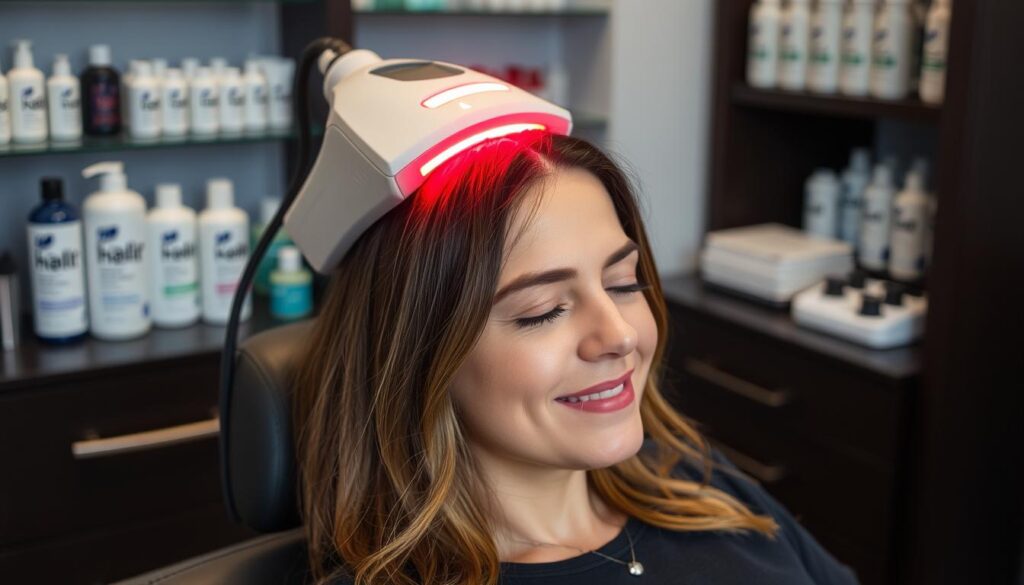Are you tired of watching your hair fall out? You’re not alone. Hair loss in women is a common issue that affects millions worldwide. But, there’s a secret to help you regrow your hair.
This guide will show you the best treatments for hair loss in women, from easy to find solutions to advanced therapies.
Key Takeaways
- Understand the common causes of hair loss in women, including genetics, hormonal changes, and medical conditions.
- Explore the gold-standard treatment for female pattern baldness the topical solution, minoxidil.
- Discover innovative therapies like laser light treatments and hormone-balancing medications.
- Learn how to manage expectations and develop coping strategies for hair loss.
- Uncover the latest breakthroughs in hair restoration and regrowth technology.
Understanding Female Hair Loss
Female hair loss, also known as androgenetic alopecia, affects about 30 million women in the U.S. It’s mainly caused by genetics and hormonal changes. This makes it the top reason for hair thinning in women.
Causes and Symptoms
Female pattern baldness leads to thinning on the top and crown of the scalp. It starts with a widening through the center hair part known as the Christmas tree pattern. Women rarely go completely bald, but hair loss can still be upsetting.
Other causes include telogen effluvium temporary shedding from stress or illness, alopecia areata an autoimmune condition causing patchy hair loss, hormonal imbalances, and nutritional deficiencies. Symptoms include a wider part line thinning hair, and bald spots.

The hair loss pattern in women is usually less severe than in men. It rarely leads to total or near-total baldness. But the emotional impact can be big. It can greatly affect a woman’s self esteem and confidence.
Hair is incredibly important to a woman’s sense of self. When she starts to lose it, it can be devastating. Dr. Melissa Piliang, a dermatologist at the Cleveland Clinic.
Diagnosis and Evaluation
If you’re dealing with hair loss, it’s key to see a professional. A dermatologist or healthcare provider will look at your scalp, check your health history, and might run tests. These steps help figure out why you’re losing hair. Then, they can make a treatment plan just for you.
The pull test is a common way to check for hair loss. The doctor pulls on about 40 strands of hair from your scalp. If more than six fall out, you’re losing hair actively. The tug test also checks how brittle or fragile your hair is, which can show hair problems.
Your doctor might also do blood tests to look for health issues like iron or thyroid problems that could cause hair loss. They might suggest a scalp biopsy too. This means taking a small scalp sample for more detailed analysis to pinpoint your hair loss type.
| Diagnostic Tool | Purpose |
|---|---|
| Pull Test | Assesses active hair loss |
| Tug Test | Evaluates hair brittleness and fragility |
| Blood Tests | Checks for underlying medical conditions |
| Scalp Biopsy | Identifies the specific type of hair loss |
Working with a dermatologist means getting a full check up and a plan to fix your hair loss.

Proper diagnosis is the key to effective treatment for hair loss in women.
Minoxidil The Gold Standard
Women facing hair loss find a reliable solution in topical minoxidil, or Rogaine. This FDA approved treatment boosts hair growth and can slow or reverse hair loss. It’s a trusted choice for many.
The 2% and 5% minoxidil solutions are available, but the 2% is often the first choice for women. Research shows the 2% is as effective as the 5% version, with fewer side effects.
Using minoxidil regularly and forever is key to keeping its benefits. If you stop using it, hair loss will likely come back. This is because minoxidil doesn’t fix the root causes of hair loss in women.
Minoxidil is recommended by 96% of dermatologists for patients concerned about hair fall.
Most people find minoxidil safe, but some might experience scalp itching or redness. Always follow the directions and apply it twice a day for best results. Using it too much won’t make it work faster.
With consistent use, you might start seeing new hair in 3-4 months, with more improvement over a year. But remember, results can differ from one person to another.

What is the best treatment for hair loss in women?
There is no single best treatment for hair loss in women. The right treatment depends on the cause of hair loss and how well someone responds to different treatments. Minoxidil is often seen as the top choice, but other options like light therapy, ketoconazole, hormonal treatments, and hair transplants might be suggested based on the situation.
Minoxidil helps about 2 out of 3 men and is also effective for female-pattern baldness. Finasteride slows or stops hair loss in almost 90% of men, with about half of them growing new hair. But, the role of biotin supplements in fighting hair loss is still unclear since there’s no solid proof of their benefits.
Laser devices and hair supplements like Viviscal or Nutrafol can help stimulate hair growth, but how well they work varies. It’s key to talk with a healthcare provider to find the best treatment plan. This might mean using a mix of treatments for the best results.

The besthair loss treatmentfor women depends on their unique situation. By understanding the causes and exploring different options, women can take steps to address their hair loss and get healthy, full-looking hair.
Light Therapy and Ketoconazole
Women dealing with hair loss can look into minoxidil and other options like low-level laser therapy LLLT and ketoconazole-based shampoos such as Nizoral. LLLT can boost minoxidil’s effects and increase hair density. Ketoconazole helps by reducing inflammation and making hair stronger.
Alternative Options
For hair loss like alopecia areata, doctors might suggest corticosteroid injections or platelet-rich plasma PRP therapy. These treatments aim to fix the hair loss causes and encourage new hair growth.
| Treatment | Description | Effectiveness |
|---|---|---|
| Low-Level Laser Therapy LLLT | A non-invasive treatment that uses low-intensity red or near-infrared light to stimulate hair follicles and promote hair growth. | A 2014 study found that LLLT significantly improved hair counts in men with androgenetic alopecia. |
| Ketoconazole Shampoo | An antifungal shampoo that can help reduce inflammation and strengthen the hair, potentially slowing down or preventing hair loss. | Ketoconazole shampoos, such as Nizoral, are often used in conjunction with other hair loss treatments like minoxidil. |
| Corticosteroid Injections | Localized injections of corticosteroids to target specific areas of hair loss, particularly in cases of alopecia areata. | Corticosteroid injections can help suppress the autoimmune response and promote hair regrowth in some individuals with alopecia areata. |
| Platelet-Rich Plasma (PRP) Therapy | A treatment that involves extracting the patient’s own blood, processing it to concentrate the platelets, and then injecting the platelet-rich plasma back into the scalp to stimulate hair growth. | PRP therapy is an emerging treatment option that has shown promising results in some studies for various types of hair loss, including female pattern hair loss. |

These alternative treatments can offer more options for women with hair loss. But, it’s key to talk to a healthcare professional to find the best treatment for your specific situation.
Hormonal Therapies
If hormonal imbalances cause hair loss, doctors might suggest hormone-based treatments. These can include birth control pills or hormone replacement therapy HRT to balance estrogen and progesterone. Antiandrogen medications, like spironolactone, might also be given to reduce androgen effects that can worsen hair loss.
Many women experience hair loss during the menopause transition. Hormones are key to the hair growth cycle. Hormone therapy can fight further hair thinning in women going through perimenopause and menopause by restoring healthy estrogen levels. Using HRT with both estrogen and progesterone is best for managing hair loss during menopause.
Bioidentical hormone replacement therapy is another option for hair loss. Anti-androgens like spironolactone can also help by stopping too much male hormone production. But, remember, using HRT for a long time can have risks. It’s important to talk with a doctor to understand the pros and cons.
Changing your lifestyle can also help with hair growth during hormonal changes. Regular exercise, managing stress, and eating a diet full of important nutrients are key. By fixing hormonal imbalances and caring for your hair, women can control hair loss and encourage new growth.
Lifestyle and Home Remedies
Making simple changes to your lifestyle and hair care can help a lot with hair loss. Gently massaging your scalp and using gentle hair products can reduce damage. Avoiding harsh styling also helps.
What you eat is key to healthy hair. Eating well and fixing any iron deficiency can help. Natural remedies like rosemary oil, pumpkin seed oil, and onion juice might also help your hair grow and look fuller.
Scalp Massage and Hair Care Routine
Scalp massages boost blood flow, which is good for hair follicles. Add it to your hair care routine to help hair grow and stop more loss. Using gentle shampoos and conditioners also protects your hair and scalp.
Nutrient-Rich Diet
Eating foods full of protein, iron, zinc, and vitamins A, B, C, and E supports hair growth. If you think you have an iron deficiency, talk to a doctor to fix it and stop more hair loss.
| Nutrient | Benefit for Hair Health |
|---|---|
| Protein | Promotes hair growth and strength |
| Iron | Supports healthy hair follicles and prevents iron deficiency |
| Zinc | Contributes to normal hair development and growth |
| Vitamins A, B, C, and E | Maintain scalp health and promote hair growth |
Using medical treatments, changing your lifestyle, and trying natural remedies together works best for hair loss. By doing these things every day, you can work towards having healthier, stronger, and more vibrant hair.
Maintaining a healthy hair care routine and addressing any underlying nutritional deficiencies can be powerful tools in the fight against hair loss.
Managing Expectations
For many women facing hair loss, managing their expectations is as important as finding treatments. Not all hair loss can be fully reversed. It’s key to be patient and focus on keeping hair healthy and well.
Outlook and Coping Strategies
Women dealing with hair loss find many ways to cope. Some wear wigs or hair garments to try new styles and feel confident. Others join support groups online or in person to share their stories and find comfort.
Counseling or therapy can also help with the emotional side of hair loss.
- Explore wig and hair accessory options to enhance your appearance and boost self-esteem
- Connect with support groups, both in-person and online, to share your experiences and find solidarity
- Consider seeking professional counseling or therapy to manage the psychological impact of hair loss
- Practice self care, such as adopting a healthy lifestyle, reducing stress, and maintaining a positive mindset
Hair loss doesn’t define your worth or beauty. By embracing your journey and focusing on well-being, you can overcome this challenge. With the right strategies and support, you’ll come out stronger and more empowered.
The true beauty of a woman is not in the clothes she wears, the figure that she carries, or the way she combs her hair. Audrey Hepburn
Conclusion
Female hair loss is a complex issue, but there are many ways to tackle it. With the right mindset and knowledge, women can get their hair back. This guide has shown the best ways to improve hair health and boost confidence.
Did you know that hair loss affects nearly half of all women at some point? It’s important to seek help if you’re facing this issue. With professional advice, you can find a treatment plan that works for you.
If you’re dealing with hair loss, don’t give up. Look into the best treatments and keep your expectations realistic. With time, effort, and the right support, you can take back control of your hair. And you’ll find beauty in your own hair again.





